Audi 2015 Annual Report Download - page 267
Download and view the complete annual report
Please find page 267 of the 2015 Audi annual report below. You can navigate through the pages in the report by either clicking on the pages listed below, or by using the keyword search tool below to find specific information within the annual report.-
 1
1 -
 2
2 -
 3
3 -
 4
4 -
 5
5 -
 6
6 -
 7
7 -
 8
8 -
 9
9 -
 10
10 -
 11
11 -
 12
12 -
 13
13 -
 14
14 -
 15
15 -
 16
16 -
 17
17 -
 18
18 -
 19
19 -
 20
20 -
 21
21 -
 22
22 -
 23
23 -
 24
24 -
 25
25 -
 26
26 -
 27
27 -
 28
28 -
 29
29 -
 30
30 -
 31
31 -
 32
32 -
 33
33 -
 34
34 -
 35
35 -
 36
36 -
 37
37 -
 38
38 -
 39
39 -
 40
40 -
 41
41 -
 42
42 -
 43
43 -
 44
44 -
 45
45 -
 46
46 -
 47
47 -
 48
48 -
 49
49 -
 50
50 -
 51
51 -
 52
52 -
 53
53 -
 54
54 -
 55
55 -
 56
56 -
 57
57 -
 58
58 -
 59
59 -
 60
60 -
 61
61 -
 62
62 -
 63
63 -
 64
64 -
 65
65 -
 66
66 -
 67
67 -
 68
68 -
 69
69 -
 70
70 -
 71
71 -
 72
72 -
 73
73 -
 74
74 -
 75
75 -
 76
76 -
 77
77 -
 78
78 -
 79
79 -
 80
80 -
 81
81 -
 82
82 -
 83
83 -
 84
84 -
 85
85 -
 86
86 -
 87
87 -
 88
88 -
 89
89 -
 90
90 -
 91
91 -
 92
92 -
 93
93 -
 94
94 -
 95
95 -
 96
96 -
 97
97 -
 98
98 -
 99
99 -
 100
100 -
 101
101 -
 102
102 -
 103
103 -
 104
104 -
 105
105 -
 106
106 -
 107
107 -
 108
108 -
 109
109 -
 110
110 -
 111
111 -
 112
112 -
 113
113 -
 114
114 -
 115
115 -
 116
116 -
 117
117 -
 118
118 -
 119
119 -
 120
120 -
 121
121 -
 122
122 -
 123
123 -
 124
124 -
 125
125 -
 126
126 -
 127
127 -
 128
128 -
 129
129 -
 130
130 -
 131
131 -
 132
132 -
 133
133 -
 134
134 -
 135
135 -
 136
136 -
 137
137 -
 138
138 -
 139
139 -
 140
140 -
 141
141 -
 142
142 -
 143
143 -
 144
144 -
 145
145 -
 146
146 -
 147
147 -
 148
148 -
 149
149 -
 150
150 -
 151
151 -
 152
152 -
 153
153 -
 154
154 -
 155
155 -
 156
156 -
 157
157 -
 158
158 -
 159
159 -
 160
160 -
 161
161 -
 162
162 -
 163
163 -
 164
164 -
 165
165 -
 166
166 -
 167
167 -
 168
168 -
 169
169 -
 170
170 -
 171
171 -
 172
172 -
 173
173 -
 174
174 -
 175
175 -
 176
176 -
 177
177 -
 178
178 -
 179
179 -
 180
180 -
 181
181 -
 182
182 -
 183
183 -
 184
184 -
 185
185 -
 186
186 -
 187
187 -
 188
188 -
 189
189 -
 190
190 -
 191
191 -
 192
192 -
 193
193 -
 194
194 -
 195
195 -
 196
196 -
 197
197 -
 198
198 -
 199
199 -
 200
200 -
 201
201 -
 202
202 -
 203
203 -
 204
204 -
 205
205 -
 206
206 -
 207
207 -
 208
208 -
 209
209 -
 210
210 -
 211
211 -
 212
212 -
 213
213 -
 214
214 -
 215
215 -
 216
216 -
 217
217 -
 218
218 -
 219
219 -
 220
220 -
 221
221 -
 222
222 -
 223
223 -
 224
224 -
 225
225 -
 226
226 -
 227
227 -
 228
228 -
 229
229 -
 230
230 -
 231
231 -
 232
232 -
 233
233 -
 234
234 -
 235
235 -
 236
236 -
 237
237 -
 238
238 -
 239
239 -
 240
240 -
 241
241 -
 242
242 -
 243
243 -
 244
244 -
 245
245 -
 246
246 -
 247
247 -
 248
248 -
 249
249 -
 250
250 -
 251
251 -
 252
252 -
 253
253 -
 254
254 -
 255
255 -
 256
256 -
 257
257 -
 258
258 -
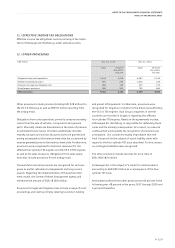 259
259 -
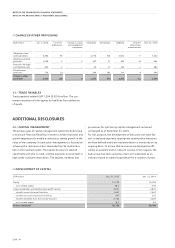 260
260 -
 261
261 -
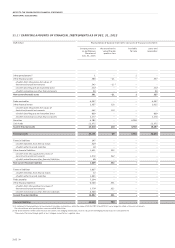 262
262 -
 263
263 -
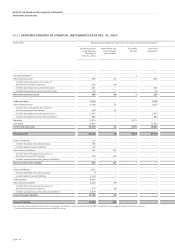 264
264 -
 265
265 -
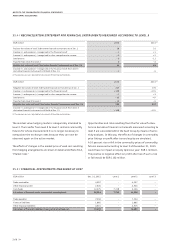 266
266 -
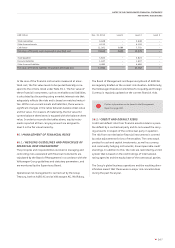 267
267 -
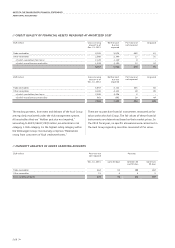 268
268 -
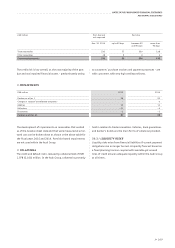 269
269 -
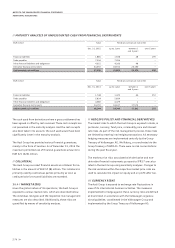 270
270 -
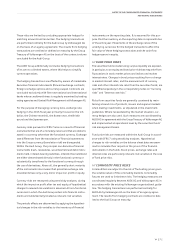 271
271 -
 272
272 -
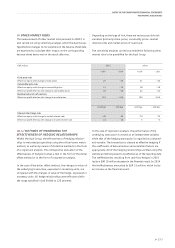 273
273 -
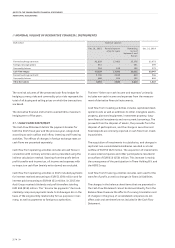 274
274 -
 275
275 -
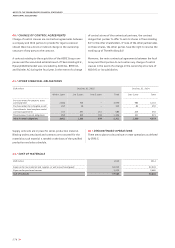 276
276 -
 277
277 -
 278
278 -
 279
279 -
 280
280 -
 281
281 -
 282
282 -
 283
283 -
 284
284 -
 285
285 -
 286
286 -
 287
287 -
 288
288 -
 289
289 -
 290
290 -
 291
291 -
 292
292 -
 293
293 -
 294
294 -
 295
295 -
 296
296 -
 297
297 -
 298
298 -
 299
299 -
 300
300
 |
 |

NOTES TO THE CONSOLIDATED FINANCIAL STATEMENTS
ADDITIONAL DISCLOSURES
>> 267
EUR million Dec. 31, 2014 Level 1 Level 2 Level 3
Trade receivables 3,648 – 3,648 –
Other financial assets 4,120 – 4,120 –
Cash funds 11,391 3,689 7,702 –
Fair values of financial assets measured at amortized cost 19,160 3,689 15,470 –
Trade payables 5,824 – 5,824 –
Financial liabilities 1,637 – 1,637 –
Other financial liabilities 4,480 – 4,480 –
Fair values of financial liabilities measured at amortized cost 11,942 – 11,942 –
In the case of the financial instruments measured at amor-
tized cost, the fair value levels to be quoted basically corre-
spond to the criteria listed under Note 35.1. The fair value of
these financial instruments, such as receivables and liabilities,
is calculated by discounting using a market interest rate that
adequately reflects the risks and is based on matched maturi-
ties. Within non-current assets and liabilities, there were no
significant changes in the ratios between balance sheet value
and fair value. For reasons of materiality, the fair value for
current balance sheet items is equated with the balance sheet
value. In order to reconcile the tables above, equity instru-
ments reported at their carrying amount are assigned to
level 3 in the fair value hierarchy.
36 / MANAGEMENT OF FINANCIAL RISKS
36.1 / HEDGING GUIDELINES AND PRINCIPLES OF
FINANCIAL RISK MANAGEMENT
The principles and responsibilities involved in managing and
controlling risks associated with financial instruments are
stipulated by the Board of Management in accordance with the
Volkswagen Group guidelines and statutory parameters, and
are monitored by the Supervisory Board.
Operational risk management is carried out by the Group
Treasury, both at AUDI AG and at Volkswagen AG, Wolfsburg.
The Board of Management and Supervisory Board of AUDI AG
are regularly briefed on the current risk situation. Additionally,
the Volkswagen Executive Committee for Liquidity and Foreign
Currency is regularly updated on the current financial risks.
Further information can be found in the Management
Report on page 169.
36.2 / CREDIT AND DEFAULT RISKS
Credit and default risks from financial assets relate to a possi-
ble default by a contractual party and do not exceed the carry-
ing amounts in respect of the contractual party in question.
The risk from non-derivative financial instruments is covered
by value adjustments for loss of receivables. The contractual
parties for cash and capital investments, as well as currency
and commodity hedging instruments, have impeccable credit
standings. In addition to this, the risks are restricted by a limit
system that is based on the credit ratings of international
rating agencies and the equity base of the contractual parties.
The Group’s global business operations and the resulting diver-
sification meant that there were no major risk concentrations
during the past fiscal year.
